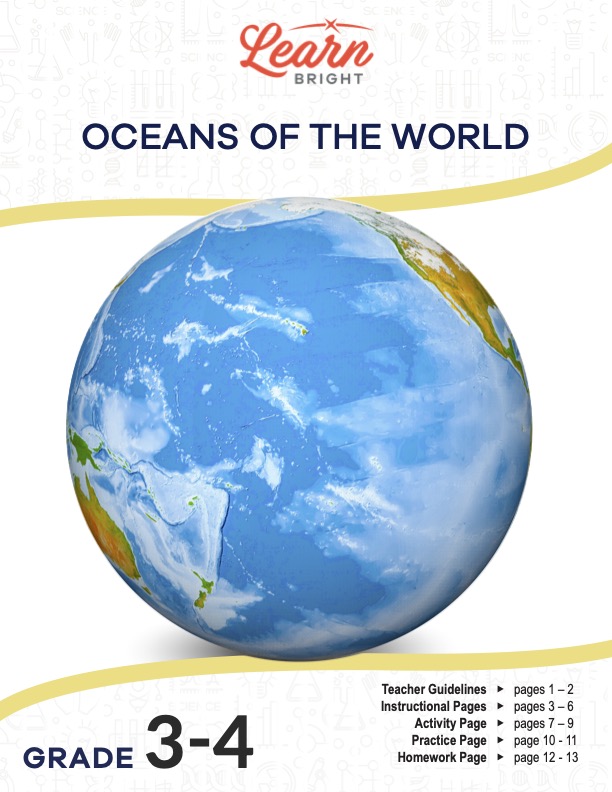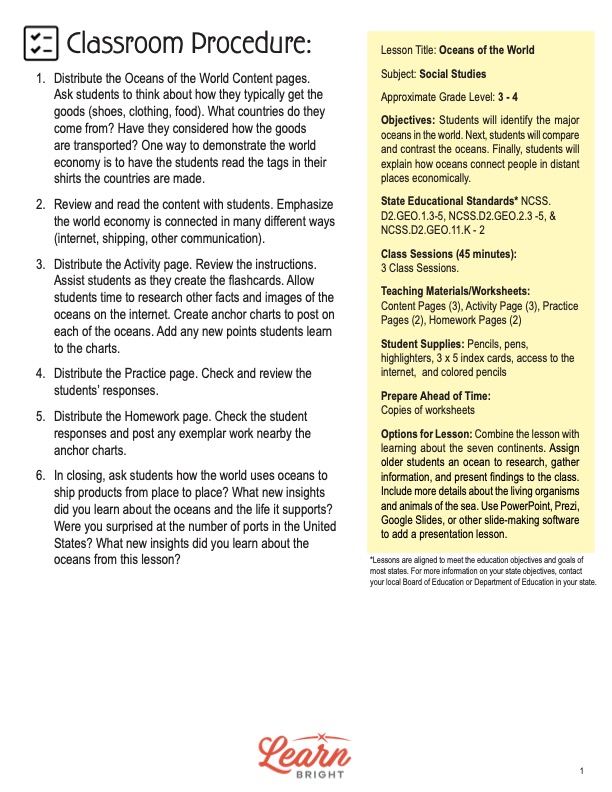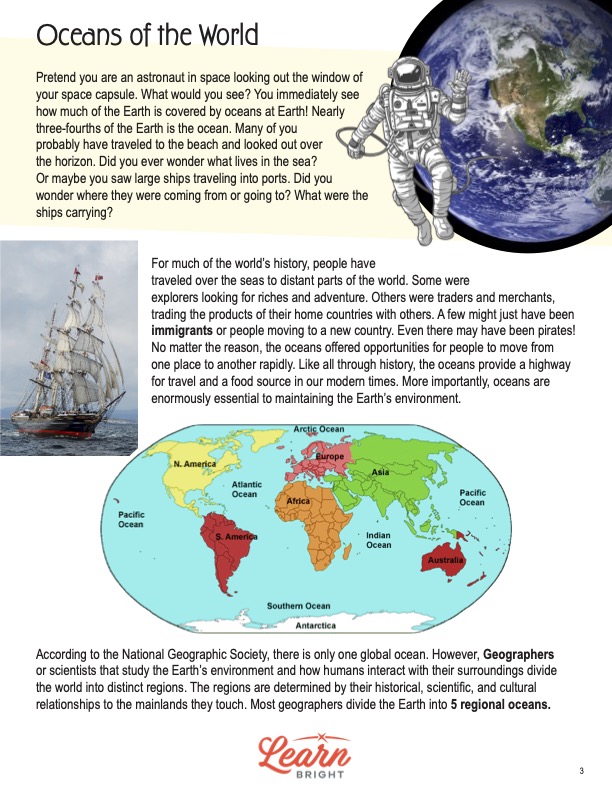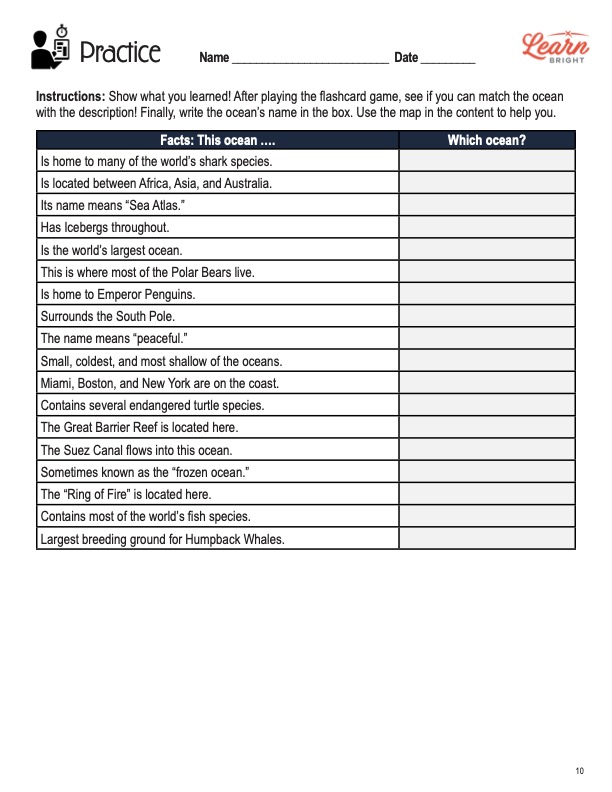Description
What our Oceans of the World lesson plan includes
Lesson Objectives and Overview: Oceans of the World teaches students about the five oceans. Students will learn facts about each ocean and the animals that live there. They will also be able to identify where in the world each ocean is. This lesson is for students in 3rd grade and 4th grade.
Classroom Procedure
Every lesson plan provides you with a classroom procedure page that outlines a step-by-step guide to follow. You do not have to follow the guide exactly. The guide helps you organize the lesson and details when to hand out worksheets. It also lists information in the yellow box that you might find useful. You will find the lesson objectives, state standards, and number of class sessions the lesson should take to complete in this area. In addition, it describes the supplies you will need as well as what and how you need to prepare beforehand. For this lesson, you will need to provide colored pencils.
Options for Lesson
There are a few suggestions in the “Options for Lesson” section that you could add to the lesson if you want to extend it or have extra time. One idea is to combine this lesson with ones about the seven continents. If you teach older students, you could assign them one ocean to research, either as individuals or groups. They can then present the information to the class. Another idea is to add more information about the various ocean animals and other living organisms to the lesson. One more suggestion is to use a multimedia presentation software of some kind to add a presentation to the lesson.
Teacher Notes
The teacher notes page provides an extra paragraph of information to help guide the lesson. It reminds you to focus on ensuring students understand the importance of oceans economically and environmentally. You can use the blank lines to write down any other ideas or thoughts you have about the topic as you prepare.
OCEANS OF THE WORLD LESSON PLAN CONTENT PAGES
The World’s Oceans
The Oceans of the World lesson plan contains three pages of content. The lesson starts off by having students pretend that they are astronauts in space looking out a window. When they view the Earth, they would see that almost 75% of the planet is blue with water. When thinking about oceans, students might wonder what lives in them or where ships are going when they leave the ports.
People traveled by sea and ocean for much of the world’s history. Some people who sailed across the waters were explorers looking for riches and adventure. Others were traders and merchants who wanted to trade their products with others. And other people were simply immigrants moving to a new country. Still others were pirates!
Oceans provided a way for people to move from place to place fairly quickly. Today, they provide a highway for travel, as well as a source of food. They are incredibly important, essential even, to maintaining the Earth’s environment. Even though the world technically has one giant ocean, geographers divide it into five distinct regions. They determine the regions by their historical, scientific, and cultural relationships to the mainlands they touch.
Pacific, Atlantic, and Indian
The Pacific ocean is the largest of the five regional oceans, covering about 30% of the Earth’s surface. It rests between the continents of Asia, North America, South America, and Australia. The word pacific means peaceful, but the Pacific Ocean is definitely not calm or peaceful! There are many volcanoes in the Pacific, called the “Ring of Fire.” Its deepest point is nearly seven miles below the surface. This ocean is where we would find the Great Barrier Reef off the Australian coast.
Next is the Atlantic Ocean, which is half the size of the Pacific. It is between the continents of North and South Americas, Europe, and Africa. Lots of sharks live in the Atlantic. Greenland, the largest island in the world, is located in this region. The word atlantic means Sea of Atlas. Famous cities near the ocean include Miami, New York City, and London.
Located between Africa, Australia, and parts of Asia is the Indian Ocean. This area is the largest breeding ground in the world for humpback whales. The Suez Canal in Egypt links the ocean to the Nile River. There are lots of endangered species in this area, such as sea turtles and seals.
Arctic and Southern Oceans
The Arctic Ocean is sometimes called the frozen ocean because it is almost completely covered in ice during the winter. It is located around the North Pole across the Arctic Circle. The smallest of the five regional oceans, the Arctic is home to many of the polar bears in the world. It is also the most shallow and the coldest. Surprisingly, there are most fish species here than anywhere else on Earth!
Finally, the Southern Ocean (also known as the Antarctic Ocean) is located around the South Pole across the Antarctic Circle. It is home to the emperor penguin and the wandering albatross. Students will learn that they could find icebergs throughout the Southern Ocean. One more interesting fact is that nobody lives along the coast of this ocean on the side of Antarctica because nobody lives in Antarctica.
All the oceans provide many benefits, such as transportation, oxygen, climate regulation, recreation, and food. In fact, the world’s ocean provide over 50% of the oxygen in the air. It provides much more than just seafood, too. Students will learn that ingredients from the ocean are in foods like peanut butter and soy milk!
The fourth content page is a short practice worksheet. Students can try to match an image to the ocean it represents. For instance, the picture of the humpback whale would represent the Indian Ocean. The picture of the Great Barrier Reef matches the Pacific Ocean. Students can use the content pages for reference for this short assignment.
OCEANS OF THE WORLD LESSON PLAN WORKSHEETS
The Oceans of the World lesson plan includes three worksheets: an activity worksheet, a practice worksheet, and a homework assignment. The worksheets help solidify students’ grasp of the lesson concepts and allow students to demonstrate their knowledge. The guidelines on the classroom procedure page describe when to distribute the handouts throughout the lesson.
FLASHCARDS ACTIVITY WORKSHEET
For the activity, students will create flashcards using information about the five oceans. The worksheet lists several facts about each ocean that students will cut and paste to either side of the cards. Students will then research more facts and add images to the cards. When they finish, they will play a flashcard game with a partner. The goal is to see if each person can determine which ocean a fact describes using the facts as clues.
OCEANS OF THE WORLD PRACTICE WORKSHEET
After playing the flashcard game, students will see if they can match facts to the correct ocean. They will read through 18 facts in the left column and write which ocean each fact represents in the right column. If they need help, they can refer to the map in the content pages.
OCEAN PORTS HOMEWORK ASSIGNMENT
The homework assignment requires students to determine which countries’ sailors might have traveled to from certain U.S. ports. First, students will make a dot at each of the seven major ports in the United States. Then they will pick two ports and draw shipping lines from the port to a country that most likely uses that port.
Worksheet Answer Keys
The lesson plan document provides answer keys for the practice and homework worksheets. The correct answers are in red to make it easy to compare them to students’ responses. The homework answer key provides a sample response, as well as a diagram of U.S. ports and of ocean transportation routes for reference. If you choose to administer the lesson pages to your students via PDF, you will need to save a new file that omits these pages. Otherwise, you can simply print out the applicable pages and keep these as reference for yourself when grading assignments.










